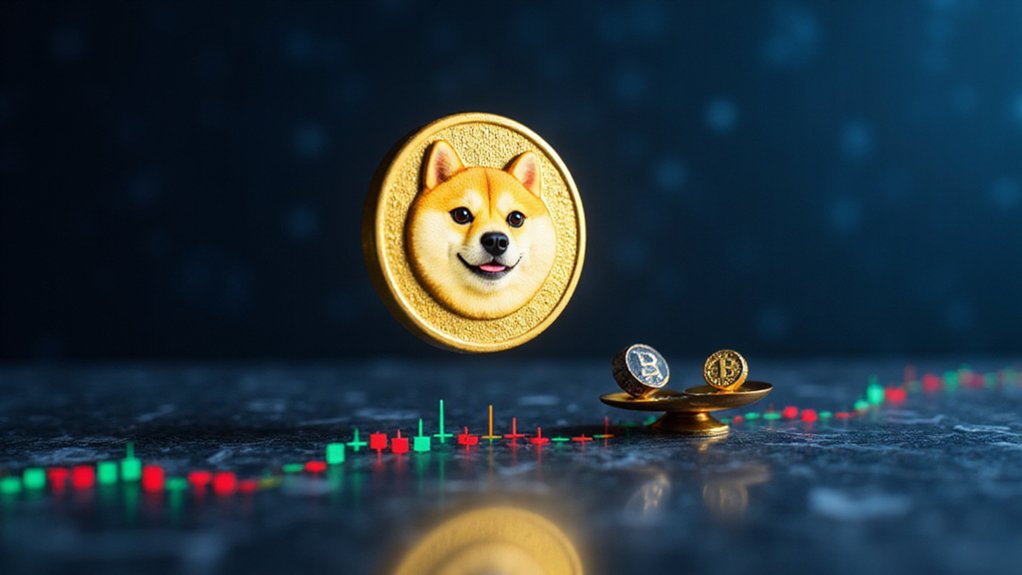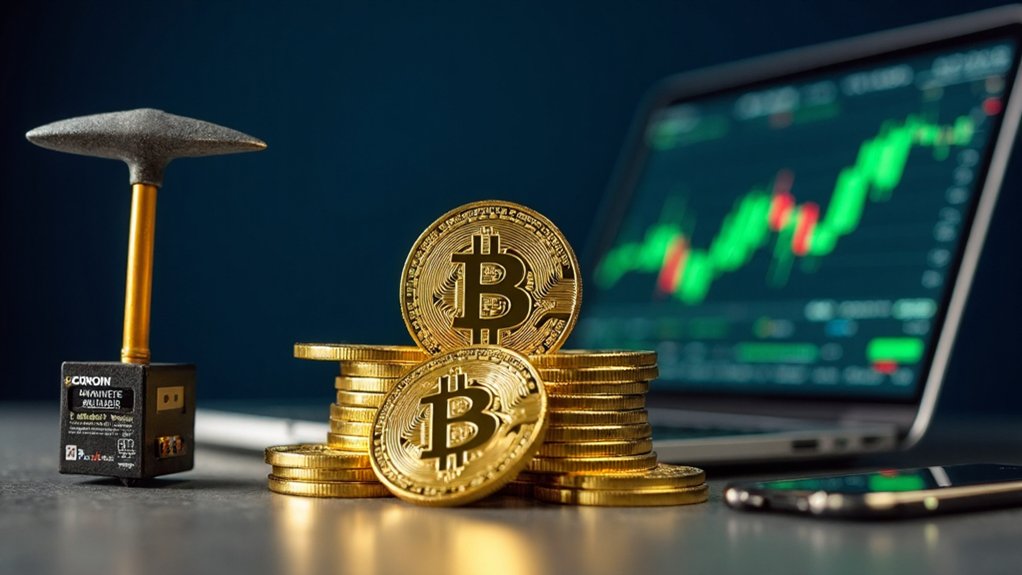Dogecoin currently trades at $0.158 per coin (mid-April 2025), with a market capitalization exceeding $23.3 billion—not bad for what began as an internet joke. Analyst projections range from $0.212 by May to an ambitious $0.57 by year-end, despite market sentiment indicators suggesting caution. Unlike Bitcoin, Dogecoin’s unlimited supply mechanism intentionally supports accessibility while creating unique price dynamics. The cryptocurrency’s value proposition extends well beyond its meme-based façade.

What exactly constitutes the “worth” of a digital asset that began as an internet joke? For Dogecoin, this question yields increasingly concrete answers as the cryptocurrency evolves from meme status to legitimate financial instrument. As of mid-April 2025, DOGE trades at approximately $0.158—a figure that, while modest compared to its more established counterparts, represents the culmination of a remarkable journey for what was once mere internet humor reified into blockchain form.
The current valuation exists within a somewhat tepid market environment, evidenced by the Fear & Greed Index hovering around 33 (firmly in “fear” territory) and price volatility of 7.35% over the past month. Technical indicators suggest investors should approach with caution, though forecasts suggest potential upside in the near term. By May 2025, analysts project average prices could reach $0.212, with subsequent months maintaining similar levels through July.
More ambitious projections—perhaps borrowing optimism from Dogecoin’s community-driven ethos—suggest substantial growth potential. DigitalCoinPrice anticipates a possible 118% increase to $0.36 by late April, while CoinCodex ventures further into speculative territory with projections reaching $0.57 (representing a staggering 200% appreciation). More conservative outlooks from Wallet Investor temper these expectations, suggesting ceiling prices closer to $0.17. This represents a significant decrease from December 2024, when Dogecoin was trading at 0.32 cents consistently.
The macroeconomic landscape inevitably shapes these projections. Federal Reserve policies, persistent recession concerns, and evolving regulatory frameworks all exert gravitational influence on DOGE’s trajectory. Additionally, the potential approval of a Dogecoin ETF looms as a possible catalyst for price appreciation. Dogecoin’s impressive market capitalization of over $23.3 billion demonstrates its significant position among cryptocurrencies despite its meme origins. With a circulating supply of approximately 148 billion DOGE and no maximum cap, the coin’s intentional abundance influences its individual unit price while supporting widespread adoption.
For traders and investors evaluating Dogecoin’s merit, the decision fundamentally balances community enthusiasm against market fundamentals. The cryptocurrency’s relatively moderate volatility provides trading opportunities within predicted ranges ($0.135-$0.24 in coming months), while long-term holders must reconcile themselves to the peculiar reality of placing faith—and capital—in an asset whose origin story includes a Shiba Inu and Comic Sans typography.
Frequently Asked Questions
How Do I Mine Dogecoin?
Mining Dogecoin requires specialized hardware (ASIC miners like Bitmain Antminer L9 or GPUs), appropriate mining software supporting the Scrypt algorithm, and joining a mining pool to increase reward consistency.
After configuring hardware and software, miners connect to their chosen pool, monitor performance metrics, and store earnings in a Dogecoin wallet.
Ongoing maintenance includes regular software updates and optimizing for energy efficiency—a critical factor in maintaining profitability in this notoriously capricious market.
Who Created Dogecoin?
Dogecoin emerged from the collaborative efforts of two unlikely cryptocurrency architects: Billy Markus, an IBM software engineer who designed the protocol using scrypt technology, and Jackson Palmer, an Adobe engineer who purchased the domain Dogecoin.com.
Launched on December 6, 2013, this satirical digital currency—initially conceived as a joke to lampoon cryptocurrency speculation—ironically attracted substantial interest, with over a million visitors flocking to the website within its first month of existence.
Is Investing in Dogecoin Risky?
Investing in Dogecoin entails substantial risk, driven by its pronounced volatility, speculative nature, and inflationary supply model.
Unlike Bitcoin’s more established foundation, Dogecoin’s value fluctuates wildly based on social media trends and celebrity endorsements rather than fundamental utility.
While offering potential for remarkable returns (the classic high-risk, high-reward scenario), prudent investors might consider portfolio diversification and implementing risk management techniques to mitigate inevitable market gyrations.
Where Can I Purchase Dogecoin?
Dogecoin can be purchased through several channels, each catering to different investor preferences.
Major cryptocurrency exchanges like Binance, Coinbase, and Kraken offer substantial liquidity with varied fee structures.
For those preferring peer-to-peer transactions, platforms such as LocalCryptos eliminate intermediaries.
Mainstream financial services including PayPal and Robinhood have integrated Dogecoin, while wallet providers like Trust Wallet and Exodus offer built-in purchase functionality—rendering the once-niche asset surprisingly accessible to both crypto enthusiasts and novices alike.
What Makes Dogecoin Different From Bitcoin?
Dogecoin differs fundamentally from Bitcoin in several key aspects.
While Bitcoin emerged as a serious financial alternative with limited supply (21 million coins), Dogecoin—born from a meme—features unlimited supply and inflationary tokenomics.
Technically, Dogecoin employs Scrypt rather than SHA-256, enabling faster transactions (30-40 TPS versus Bitcoin’s 3-7) and lower fees.
Dogecoin’s community-centric ethos and micropayment utility create a distinctly different value proposition than Bitcoin’s “digital gold” narrative.









